
|   |

|   |
Fifth edition of Keremane Shambhu Hegde Rashtriya Natyotsava - Sudha Sridhar e-mail: sudhasridhar@hotmail.com Photos: Raghavendra Sastry & Shashidhar Keremane February 12, 2014 The hallowed turf of Yakshagana, Gunavante sent clear signals to the art world that art for heart and heart for art is all that is required to ensure that the traditional as well as contemporary art forms survive and is passed on to posterity. That a village the size of Gunavante, calm, serene, peaceful could string together a festival of such grand scale speaks volumes about how much one can do when working with a clear purpose. The fifth edition of the five day festival organized by Sri Idagunji Mahaganapati Yakshagana Mandali Keremane, took place from January 18 to 22, 2014. A brief day by day account is provided to enable one to get a brief view of the proceedings. January 18: The inauguration saw the director of the festival Keremane Shivananda Hegde doing puja to the kirita, the crown that is adorned during the Yakshagana performance by the Keremanes. This was followed by the presentation ceremony of the ‘Keremane Shivarama Hegde Award’ with a kolattam in a traditional fashion and a warm welcome extended to Chittani Ramachandra Hegde, the recipient of the prestigious award for the year 2013 for his stellar contribution to Karnataka Yakshagana. Keremane Shivarama Hegde is known as the ‘Dhruvtara’ of Karnataka Yakshagana – only one of his stature in the entire history and the award is instituted in his name. 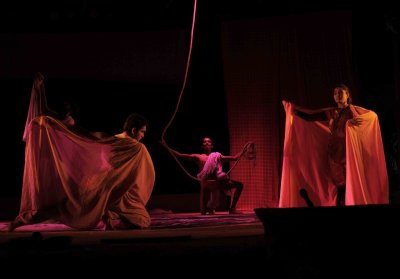 Purushasukta The first day’s cultural program featured Purushasukta, a contemporary exploration of a cosmic hymn by Abhijnana Theatre Research Foundation. The basics of Koodiyattam, Kalaripayattu and that of Yakshagana were visible in the neat and commendable presentation by the artists. However, better handling of the story line up and dramatization would have enabled the audience to connect much more with an abstract subject like Purushasukta. Bharatanatyam by Ganna Smirnova from Ukraine saw her excel in abinaya in the items, Devi Mangalam and Jayadeva’s ashtapadi while her remarkable footwork was a sight to watch in Revati tillana. Natya Institute of Kathak and Choreography presented ‘Saare Jahanse Achchaa,’ a dance drama choreographed by Guru Dr. Maya Rao. A delightful confluence of dance and technology in the backdrop with interesting graphics considerably increased the production value. January 19: From day two, the organizers lined up seminars to go in tandem with the evening’s cultural program. The seminar titled ‘Raga Samvada,’ a discussion on raga tradition in Karnataka Yakshagana, Carnatic and Hindustani music provided insight into the subtle differences primarily in connection to that of Yakshagana sangeetham. Though the name and the notes of the ragas look similar in each stream, the rendering methodology is quite different. Yakshagana sangeetham / ragas could be easily analyzed by Carnatic musicians but while doing so they need to understand that Yakshagana sangeetham doesn’t per se follow a methodology and it would be better not to dissect further since the same would dilute the purity of the original composition. Further it was clearly brought out that in Yakshagana sangeetham, the importance is more on literature and the nature / bhava of the characters portrayed. 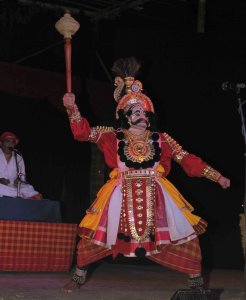 Chittani Ramachandra Hegde as Duryodana For the second day’s cultural program, this year’s Keremane Shivarama Hegde Award recipient Chittani Ramachandra Hegde along with his group presented a Karnataka Yakshagana ‘Gada Yudha.’ The characterization and story dramatization made the audience take pity on the sad plight of Duryodhana in contrast to the general feeling of resentment one associates with his misdeeds right through the Mahabharata epic. That was the skill with which Chittani performed showing no signs of his age at any point of the vigorous play. Kuchipudi dance recital by Sailaja along with two of her disciples saw a presentation on a composition of Pappu Venugopala Rao, Pushpanjali wherein the variations of the nritta aspect was well appreciated by the audience. In tarangam, the continuous flowing movements and the jathis on plate were quite remarkable. The sculpture like poses that was shown in “Sankara Sri Giri” was appreciable. In the last item ‘Mahishasuramardini’ the trio’s emotions were apt and brought cheers from the audience. Within the given time, Sailaja had thoughtfully planned her recital to showcase all the essential aspects in the repertoire of Kuchipudi classical dance form. Prince Dance Company, known for their award winning efforts in a TV reality show, kept the audience spellbound with their precise eye pleasing formations. Even without any formal training in dance the methodical performance of the group was appreciable. January 20: The morning seminar had a very nostalgic subject on the cards: ‘Sri Idagunji Mela - 80 years, Achievements & Contributions.’ The journey so far of the mela could be summed up as the first generation setting in place the concept and establishing the mela. The second generation took it to legendary proportions with performance and reaching out in a big way beyond the state and country. The third generation at the helm of affairs currently is putting in place efforts to take it one notch higher with more participation, appreciation and involvement from all quarters. The role of the three generations, though they overlap each other, can be primarily in corporate parlance put across as stages of conceptualisation, construction and consolidation. One interesting aspect of the growth so far has been the mutual influence and contribution the art had on the society and vice versa. The seminar discussion covered in detail the struggles, challenges, growth, team work, triumphs of the past glorious decades. The third day’s cultural program commenced with Kathak by Nadam ensemble led by Nandini K Mehta and K Murali Mohan. Their first item depicted the beauty of nature observed during the period of Basant. Later, the team performed a stuthi on Lord Nataraja followed by a thumri, teen taal and Madurashtakam. The traditional techniques were showcased in full flow with almost no intrusion of modern approach by the group. 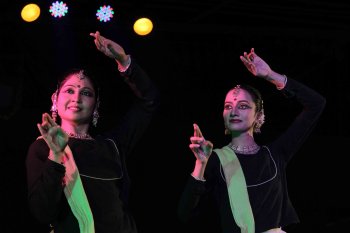 Kathak by Nadam ensemble 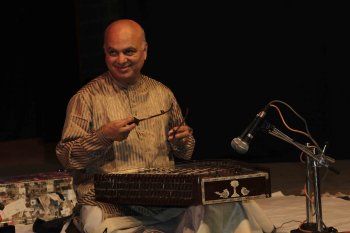 Pandit Satish Vyas 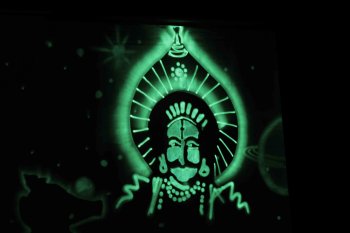 Glow Art by Vinay Hegde 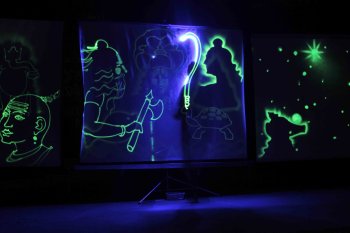 Glow Art by Vinay Hegde Santoor recital by Pandit Satish Vyas accompanied on tabla by Ustad Fazal Qureshi was like nature itself was celebrating the serene environs through the music that emanated from the duo. It was good to see both unabashedly cherishing the concert like a bystander. Vyas did mention during the course of the recital how much he appreciated and enjoyed the concert set in a very natural setting which goes well for an instrument like santoor. Glow Art by Vinay Hegde followed the mesmerizing santoor recital and little did the audience know about the really mind blowing art show that was to be witnessed. Vinay had used a canvas and light in a very innovative fashion to bring about a new genre of art form to the forefront. The uniqueness about this art is that the light itself is used to paint any picture on the canvas which would typically last only for a few minutes before the image diminishes naturally. The stage saw a luminous painting spring out from the black depth, the Dasavatar characters in minute detail, and a pleasant surprise when an adept drawing of Keremane’s face with Yakshagana attire was featured by Vinay. January 21: The morning seminar witnessed a demonstration of ‘Ekavyakti Yakshagana’ by Ravi Alevooraya. Yakshagana generally performed as a group is now witnessing some efforts to have a solo offshoot too with parts of the bigger drama depicted by an artist. There are lot of areas to work in the process and challenges to be surmounted. The fourth day’s cultural program featured Hindustani classical vocal by Pandit Shripad Hegde who began with a thumri. He rendered the Kannada bhajan “Kandane pandari rayana” remarkably adapted in Hindustani style. 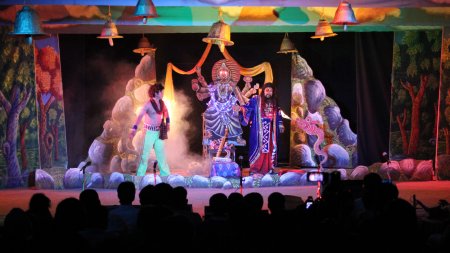 Drama by Surabhi The much awaited theatre treat from Surabhi headed by R. Nageswara Rao was a visual treat. Though the language of dialogue was in Telugu, the high production value with the props, screens, puppetry, and so many imaginative innovations kept the audience engrossed. Even the subtle jokes which were in very colloquial Telugu saw the basically Kannada speaking audience also understand and enjoy proving that for true artists, language is not a barrier at all. The very bright colours coupled with the brisk screen play, frequent changing of the backdrop with no interruption left one to wonder how the troupe is managing to perform at such speed. January 22: The morning session saw a seminar ‘Apoorva Poorvasmarane’ on recalling the contributions of legendary Karnataka Yakshagana artistes, Paramayya Hasyagara Karki and Kuriya Vithala Shastri. During the discussion, the greatness of both the artists was elucidated as how actors are different from stars and how deservingness is different from destiny. Both of them had a very good fan following and were good artists but not considered as stars. However, to know the real greatness of an artist one needs to go in-depth into their life and times from a biography perspective where one will get to know many aspects about the journey of the Yakshagana form itself through their story. On the final day of the festival, the ‘Keremane Gajanana Hegde Award’ for the year 2013 was presented to Kunjalu Ramakrishna Nayak, senior Yakshagana artist Brahmavara. During the course of the festival the felicitations of the Keremane Shambhu Hegde Rashtriya Natyotsava saw a big list of personalities drawn not only from Karnataka Yakshagana artists and gurus, but also organizers, art patrons, scholars, sculptors, and so on. This gave ample proof of the genuine efforts on the part of the festival to applaud the contribution in all quarters and ensuring that the art form gets its due place in the modern day perspective. In the fifth day’s cultural program, Ananya troupe presented Bharatanatyam and Kathak compositions. Manasa Joshi’s Kathak performance adapting a Kannada song choreographed neatly in Kathak form was brilliant. Priya Raman, Sruthi Rajyalakshmi and Deepti Radhakrishna performed Bharatanatyam starting with a composition ‘”Kavya nritya dhare” in Todi ragam set to adi tala which was followed by Purandaradasa and Kanakadasa keertanas. Footwork and abhinaya by the trio was exceptionally good, and one observed that there was influence of Kuchipudi’s components like sanchari, dramatization, one dancer portraying two characters simultaneously which was well received by the audience while the same cannot be said for purists of Bharatanatyam. The back to back performance by Surabhi was a double treat and the audience truly cherished watching the story ‘Sasirekha parinayam’ enacted. The well organized festival packed with music, dance and art had something for everyone, never had a dull moment and kept one asking for more at the end of it. The full credit for the success goes as rightly acknowledged by Keremane Shivananda Hegde during the course of the festival, to all those who made it possible, right from the hospitality of the ever enthusiastic totally involved organizers to the sponsors, dedicated performances of the artists and of course the appreciative audience who savored the wonderful medley of art that was offered during the festival. Sudha Sridhar is a Kuchipudi artiste and runs her own dance school Nartana Academy of Performing Arts in Bangalore. |